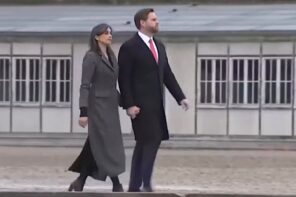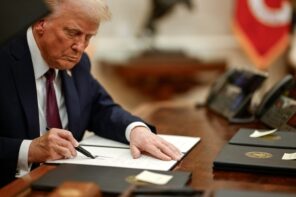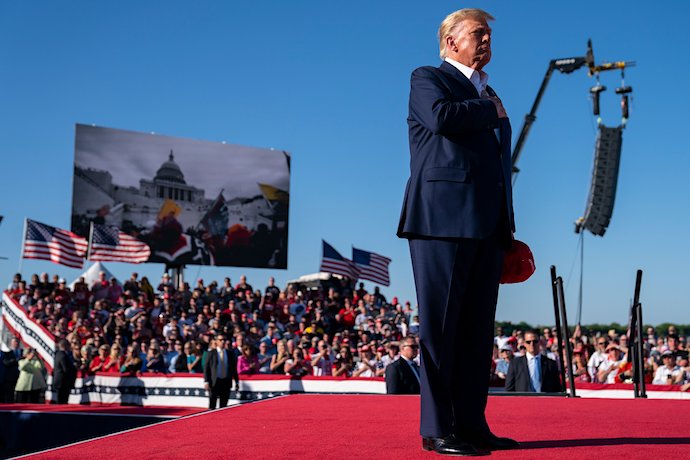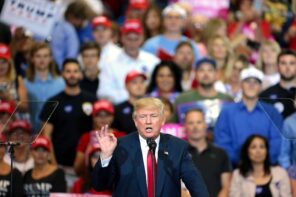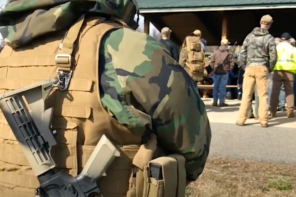Donald Trump’s Waco rally this past weekend was, in the end, filled with echoes of the 1993 siege of the Branch Davidian compound—just not the kind we like to talk about. And, despite the New York Times profile of the Q-adjacent pastor Charles Pace, who lives on the site of the former Branch Davidian compound,* and his lurid quotes (“Donald Trump is the anointed of God… He is the battering ram that God is using to bring down the Deep State of Babylon”), there was no meaningful connection between the rally and the Branch Davidians.
No, the echoes have nothing to do with the siege itself and everything to do with the spectators to the siege, like Timothy McVeigh, who subsequently retaliated against the US government via the 1995 Oklahoma City bombing, which killed 168 people. It’s the dog whistle to the far-right blown right next to the kennel. It’s the weight of far-right, anti-government, antisemitic, racist violence in the former president’s rhetoric that tacitly marks the 30th anniversary.
We’ve had weeks now of Trump’s accelerating rhetoric of violence and apocalypticism. His CPAC speech, for example, calling for “the final battle,” in the midst of an event already marked by incredibly violent, genocidal rhetoric; not to mention the increasingly wild calls for holy war and violence in his Truth Social posts leading up to the rally:
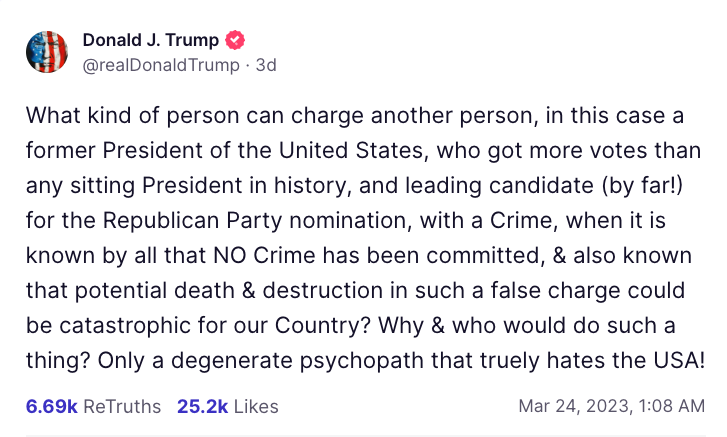
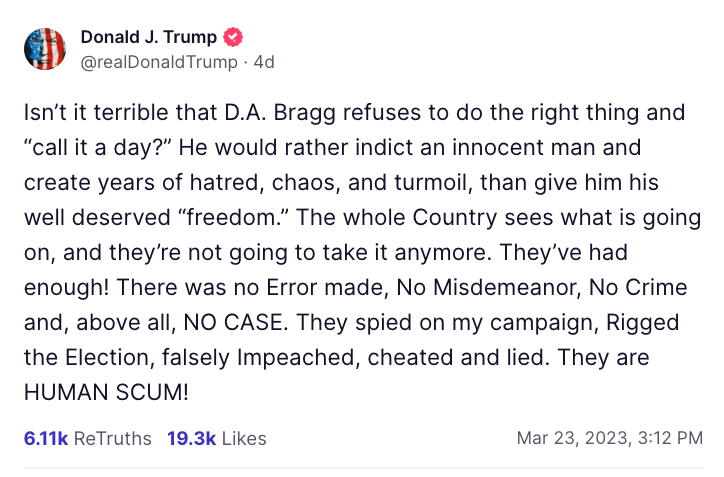
“Degenerate psychopath,” “human scum,” and, in another post, “Soros backed animal,” and “doing the work of Anarchists and the Devil,” all refer to Manhattan District Attorney Alvin Bragg Jr., who happens to be Black. It’s no coincidence that most of these are terms that have been used by authoritarians in the past to mark their political enemies as less than human—be it the Manhattan DA, people of color, queer people, Democrats, or everyone to the left of Donald Trump—one of the characteristics of genocidal speech.
This is the rhetoric of violence, the call for stochastic terrorism. And the Waco rally is a combination of these Trumpisms. First there are the “sir” stories, the petty grievances, mockery of political opponents, and even the declarations about what “strong shoulders” he has. Then there are the casual calls for violence against Alvin Bragg, Democrats as a whole, or prosecutors around the country, not to mention the recently adopted apocalyptic refrain that marks the 2024 campaign. To open with an escalatory rally like this presumably sets the tone for his campaign going forward.
That last aspect, the apocalyptic refrain, deserves some attention, because it ramps the calls for violence up to the next level, announcing Trump 2024 as an eschatologically driven campaign that requires the destruction of opponents. Indeed, as one of the opening speakers, Texas Agriculture Commissioner Sid Miller, said:
“we got a big fight ahead of us… when I started in politics a few years back, it was the Republicans versus the Democrats, and then it changed into something totally different, it became conservatives against liberals, and now we’ve gone beyond that, and I’m convinced today, that it’s patriots versus the traitors. And I’m a patriot, what about you?”
That kind of rhetoric was only amplified by the display that preceded Trump’s speech, with the former president posing stoically on stage as footage from the January 6th insurrection played on the screens behind him with the speakers blaring “Justice for All”—a song by Trump and the J6 Prison Choir released to raise money for the insurrectionists’ legal aid fund.
The song itself is a compilation of Trump reciting the Pledge of Allegiance and the choir singing “The Star-Spangled Banner,” harmless enough if not for the official endorsement of the insurrection and the repeated claims of their false imprisonment, horrible treatment, and status as patriots—i.e., martyrs to the cause. The audience had previously been asked to stand and place their hand on their heart—not in a salute to the nation, but to honor the martyrs of the insurrection.
Fascists need martyrs—they need blood to sanctify the ground they walk on, and to call for even more sacrifice from supporters. Trump hasn’t explicitly spoken of “Blutzeugen” yet, of “blood witnesses,” as the Nazis called their “martyrs,” or of a “baptism of blood,” as Hitler and his cronies called the Nazis regarding their failed coup of 1923. But he doesn’t have to at this point to make the parallel more obvious—because Ashli Babbitt has long become a martyr of the movement, as Jeff Sharlet has shown, as have the still-living insurrectionists behind bars (who can, conveniently, still record propaganda songs).
It was a moment that took the new Trumpist version of the Lost Cause—i.e., the “Stolen Election,” which functions as the Trumpist “stab in the back” myth—to new theological heights, having remnants of the faithful coming together, honoring their martyrs, and vowing that vengeance shall be theirs.
As Peter Manseau wrote:
A year after January 6 I published an essay in @NYTOpinion warning that we might one day see official valorization of Capitol rioters.
I did not expect we would so soon witness the insurrection turned into a liturgy: An act of sacred ritual remembrance.
That's where we are. https://t.co/o2NDDTzZGF
— Peter Manseau (@plmanseau) March 26, 2023
This wasn’t the only moment where a Trump rally engaged with problematic music. Not for the first time, the rally played music resembling the QAnon theme song, “Wwg1wga,” much as he did in September in Ohio.
It might be easy to dismiss the cheesy version of the “Star Spangled Banner” or the QAnon tune (which reeks of stock music one might find using the search terms “epic” and “mystical spa sounds”) as laughable; as a shrill heretical parody of what liturgy, hymns and sermons are. But it would also be short-sighted, because for those within the crowd, the music, the spectacle, the “God, Guns and Trump” signs, and the red hats may create an exhilarating, even spiritual, experience for the audience.
These are all remnants of a social uniform that allows members of the in-group to recognize one another, and fascism is a spectacle of aesthetics. Its events are choreographed to let the individual become part of the mass, the volk, the true patriots, the ones who are worthy—worthy of freedom, or of life itself (of course, if some are worthy, by definition that leaves others unworthy of these things). The incorporation of music, almost liturgical with call-and-response type elements, fits all too well into a fascist spectacle of aesthetics. This goes well beyond the mood enhancing aspect of the songs other candidates walk on to—it’s the music of the most reactionary elements of Trump’s supporters, given official recognition and a place in the performance, all of which is designed to bring the rest of the crowd with them.
And again, there’s Trump’s rhetoric. When he referenced his CPAC speech, commenting on the pushback he got for it, he said, “I am your warrior, I am your justice… For those who have been wronged and betrayed… I am your retribution, we will take care of it.”
In his autobiography, Italian fascist leader Benito Mussolini wrote, “What did Italy need? An avenger!… It was necessary to cauterize the virulent wounds…and eliminate evils which threatened to become chronic.” It is this rhetoric, the rhetoric of purging evil through violence and revenge, through purification of the nation itself, that marks fascist speech. Historian Ruth Ben-Ghiat chillingly analyzes the historical predecessors of Trump’s rhetoric and explains why fascist leaders present themselves as innocent victims:
“The focus on victimhood sets up any repressive action by the state as self-defense. It justifies the literal weaponization of government, with violence used against enemies “for the good of the nation.” The “public safety laws” that jailed leftists and transformed Italy into a police state in the 1920s upheld this fiction. And Nazi policies did not just make good on Adolf Hitler’s vows to punish elites who had “stabbed Germany in the back” by accepting the draconian terms of the Versailles Treaty (which held Germany responsible for all moral and material damages incurred during World War One). They also targeted groups that Hitler identified as threats to Germany’s survival in the future. These included Jews (“black parasites of the nation”); Bolsheviks (the “scum of humanity”); and war profiteers and international capitalists—the forerunners of the “globalists” Trump regularly denounces, including in this CPAC speech.”
Trump’s rally speech emphasizes this kind of violent victimhood, to call for similar repression. In Waco, he said, “2024 is the Final Battle, that is going to be the big one. You put me back in the White House, their reign will be over and America will be a free nation once again.”
And even more aggressively, he emphasized the violent conflict that would be necessary, concluding:
“Together we are going to finish what we started, with you at my side, we will totally obliterate the Deep State, we will banish the warmongers, from our government, we will drive out the globalists and we will cast out the communists and marxists. We will throw off the corrupt political class, we will beat the Democrats, we will rout the fake news media, we will stand up to the RINOs and we will defeat Joe Biden and every single Democrat. We will liberate America from these villains and tyrants who are looking to destroy our country.
No matter what they throw at us, no matter what they do to us, we will not bend, we will not break, we will not yield, we will never give in, we will never give up. We will never ever back down, and we will complete the mission. We will cross the finish line. We will demolish tyranny, and we will rescue liberty and justice, and we will restore the American Republic to all of its glory, better than ever before.”
And yet, this manages to be more moderate than earlier sections. An hour before, he had said,
“The stakes of this election could not be more clear. Either we surrender to the demonic forces abolishing and demolishing and happily doing so [to] our country, or we defeat them in a landslide on November 5th in 2024. Either the Deep State destroys America or we destroy the Deep State. That’s the way it’s gotta be.”
This language isn’t going to whip up a new January 6th—the failure to launch of the protests he called for last week is an important marker of Trump’s ability to summon the mob (although it has been a very lucrative stunt for him in regard to funding)—but the language of the Waco rally, and presumably the rest of the campaign, is a call to stochastic terrorism, a far-right grievance mongering given a language and a target for its violence. The enemy is the QAnon Deep State.
Democrats are not merely opponents, they are “demonic forces.” Every antisemitic dog whistle you could ask for is used—“globalists,” blending with Ted Nugent’s complaints about supplying Ukraine by calling President Zelensky (who is Jewish) a “homosexual weirdo,” and the unending use of “Soros backed” to describe opponents.
There’s also violent anti-immigrant and anti-Hispanic rhetoric throughout the speech—and this is a state where that rhetoric from the governor and former president almost certainly contributed to a mass shooting. There are nods to Trump’s 2018 relocation of the US embassy from Tel Aviv to Jerusalem, to the ongoing fight against ISIS, and to the claim that Iran has attacked the US in 78 locations—an unsubtle nod to rhetorics of Christian violence. And throughout, the claiming of a meme, “They’re not coming after me, they’re coming after you, I’m just standing in the way.”
Trump has now even managed to top his own authoritarian fever dreams styling himself not only as future president and bringer of justice who will right the supposed wrongs suffered by his supporters, but he’s also the arbiter of divinely sanctioned vengeance, the purveyor not merely as any dictator would claim, of justice, but of retribution.
In retribution, there’s a promise of suffering, of inflicting pain on those who have supposedly wronged you and your kind. It fits darkly with the pleasure that the jackboot relishes in when inflicting suffering on his enemies—because, as Trump told his crowd, it isn’t loss or victory at the end of this 2024 election season. The fascist only knows extremes: either, they vanquish their enemies or their own existence is wiped out.
And this is where the “death culture” aspect comes in. Trump’s message to his supporters is that it isn’t just the election on the line, everything is on the line: body, mind, soul, nation, identity. It ends in total victory or total defeat. And if this doesn’t induce echoes of the darkest periods in recent history, it might be time to read up on the history of fascism and the language it uses.
At the same time, Trump’s claims of rampant killings of Americans which supposedly go unpunished and his claims that “the Biden regime” is just like “Stalinist Russia” is on track with Marjorie Taylor Greene’s hallucinatory claims of Democrat-sent death squads roaming the country and killing conservatives. It’s the lie of violence through the political enemy to justify atrocities in the future and re-style them as either preventative violence or, even better, as acts of self-defense.
The “accusation in a mirror” is not for nothing one of the warning signs scholars of genocide point to. If his 2016 inauguration speech spoke of “American carnage,” Trump has escalated this message to “American retribution”—with himself as the avenger willing and able to destroy the political enemy.
It comes back to choosing Waco as a site for the rally. Trump’s rhetoric has gotten more apocalyptic, taking pre-existing calls for violence and amping them up. He’s taken the mantle of martyrdom as he launches his campaign, hammering home the messages that his followers are persecuted, that violent insurrection was righteous, and that the J6 prisoners are the true patriots.
It likely won’t lead to mobs in the streets. But with this rhetoric Trump is playing with the same fire that inspired far-right networks who were in the 90s activated by Ruby Ridge and Mount Carmel. And if the government is the enemy, if Trump’s enemies are inhuman, if the stakes are the very survival of America and the end of the world, this is fuel for the next domestic terrorist incident.
*CORRECTION: This essay incorrectly identified Charles Pace as “the current leader of the Branch Davidians.” In fact, while he was a Branch Davidian in the 1970s, Pace was never a follower of David Koresh, doesn’t appear to have the support of any surviving Branch Davidians, and there’s little reason to associate his beliefs with those of the Branch Davidians.
